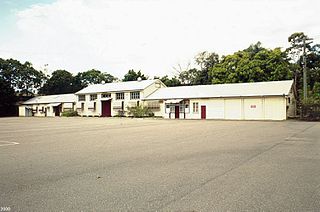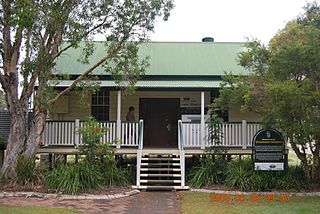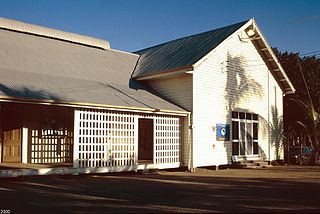
HMQS Gayundah was a flat-iron gunboat operated by the Queensland Maritime Defence Force and later the Royal Australian Navy. She entered service in 1884 and was decommissioned and sold to a civilian company in 1921. She then served as sand and gravel barge in Brisbane until the 1950s, when she was scrapped. In 1958, Gayundah was run aground at Woody Point near Redcliffe, to serve as a breakwater structure.

Kangaroo Point is an inner southern suburb in the City of Brisbane, Queensland, Australia. In the 2016 census, Kangaroo Point had a population of 8,063 people.

The Kangaroo Point Cliffs are heritage-listed cliffs located at Kangaroo Point just across the Brisbane River from the Brisbane CBD in Queensland, Australia. A popular recreation spot, especially for climbing and running, they are conveniently close to the city and the South Bank Parklands. It can be reached by the Pacific Motorway, South East Busway or a ferry to Thornton Street ferry wharf. The cliffs were formed after stone was quarried from the site and used in the construction of a number of local structures in the Moreton Bay penal settlement.

Customs House is a heritage-listed customs house at 427 Queen Street, Brisbane CBD, Brisbane, Queensland, Australia. It was designed by Charles H McLay and built from 1886 to 1889 at a cost of £38,346 by John Petrie & Son. It was originally used for the collection of customs duty and was opened in 1889, when Queensland was a British colony, replacing the original Customs House located at Petrie Bight. It was added to the Queensland Heritage Register on 7 February 2005.

Howard Smith Wharves is a heritage-listed wharf on the Brisbane River at Boundary Street, Brisbane City and Fortitude Valley, City of Brisbane, Queensland, Australia. It was built from c. 1934 to 1940s circa. It is also known as Brisbane Central Wharves. The 3.5-hectare (8.6-acre) site is one of the most culturally and historically significant riverfront locations in Brisbane. It was added to the Queensland Heritage Register on 4 February 1997.

Yungaba Immigration Centre is a heritage-listed former immigration hostel at 102 Main Street, Kangaroo Point, City of Brisbane, Queensland, Australia, alongside the Brisbane River. It was designed by John James Clark and built c. 1885 by William Peter Clark. It is also known as Yungaba Immigration Depot, Immigration Barracks, and No.6 Australian General Hospital. It was added to the Queensland Heritage Register on 21 October 1992.

Commissariat Store is a heritage-listed storehouse at 115-127 William Street, Brisbane City, City of Brisbane, Queensland, Australia. It is bordered by William Street, Queen's Wharf Road and the Brisbane River, and is the birthplace of Queensland. It was designed by William John Dumaresq and built from 1828 to 1913 by convict labour under the direction of Captain Logan as a permanent Commissariat Store for the Moreton Bay penal settlement. It is also known as Government Stores, State Stores Building, and Colonial Store. It was added to the Queensland Heritage Register on 21 October 1992.

Toowoomba railway station is a heritage-listed railway station on the Western line at Russell Street, Toowoomba, Toowoomba Region, Queensland, Australia. It serves the city of Toowoomba, which is the junction for the Western, Main and Southern lines. The station has one platform with a passing loop, opening in 1867. It was designed by FDG Stanley and built in 1873 by R. Godsall. It was added to the Queensland Heritage Register on 21 October 1992.

St Mary's Anglican Church, often called now St Mary's-on-the-Cliffs, is a heritage-listed churchyard at 433, 447 & 449 Main Street, Kangaroo Point, Queensland, Australia. It was designed by Richard George Suter and built in 1873 by Alfred Grant. It was added to the Queensland Heritage Register on 21 October 1992. Kangaroo Point Cliffs Park was constructed to the church's south in 2010 and a gateway allows park users to visit the church's grounds.

The Department of Primary Industries Building is a heritage-listed former public service building at 99 William Street, Brisbane City, City of Brisbane, Queensland, Australia. Prior to its adaptation for public service offices, it operated as the William Street Immigration Depot. It was added to the Queensland Heritage Register on 4 July 1995.

Gona Barracks is a heritage-listed barracks at 3, 7,12, 25 & 26 Gona Parade, Kelvin Grove, City of Brisbane, Queensland, Australia. It was built from c. 1914 to 1960s. It is also known as Kelvin Grove Military Reserve and Kelvin Grove Training Area. It was added to the Queensland Heritage Register on 7 February 2005.

CSR Refinery is a heritage-listed former refinery at Lamington Street, New Farm, City of Brisbane, Queensland, Australia. It was built from 1892 to 1893. It is also known as Colonial Sugar Refining Company Refinery of New Farm. It was added to the Queensland Heritage Register on 21 October 1992.

Naval Offices is a heritage-listed office building at 3 Edward Street, Brisbane City, City of Brisbane, Queensland, Australia. It was designed by Department of Public Works and built from 1900 to 1901 by J Mason. It was added to the Queensland Heritage Register on 21 March 2013.

The Old Logan Village State School is a heritage-listed former state school with teacher's residence at River and Wharf Streets, Logan Village, City of Logan, Queensland, Australia. It is also known as The Village of Logan Provisional School. It was added to the Queensland Heritage Register on 3 December 2007.

Gataker's Warehouse Complex is a heritage-listed warehouse at 106-108 Wharf Street & 310 Kent Street, Maryborough, Fraser Coast Region, Queensland, Australia. It was designed by James Buchanan and built in 1879 by F Kinne and Jack Ferguson. It is also known as Graham and Gataker, Netterfield and Palmer, Rutledge and Netterfield, and Gatakers Warehouse. It was added to the Queensland Heritage Register on 21 October 1992.

The Rockhampton Customs House is a heritage-listed customs house at 208 Quay Street, Rockhampton, Rockhampton Region, Queensland, Australia. It was built from 1899 to 1900 by Caskie and Thompson. It was added to the Queensland Heritage Register on 7 February 2005.

The WH Paxton & Co. Buildings are a heritage-listed group of offices and warehousing at 10 River Street, Mackay, Mackay Region, Queensland, Australia. The 1899 sections were designed by Mackay architect Arthur Rigby and constructed by Charles Porter and Joseph Vidulich (warehouse). The 1912 warehouse extension was designed by Brisbane architect Montague Talbot Stanley. It was added to the Queensland Heritage Register on 14 August 2008.

Townsville Customs House is a heritage-listed former customs house at Wickham Street, Townsville CBD, City of Townsville, Queensland, Australia. It was designed by George David Payne and built from 1900 to 1902 by Crawford & Cameron. It was added to the Queensland Heritage Register on 7 February 2005.

North Ward Defence Complex is a heritage-listed barracks at 46 Oxley Street, North Ward, City of Townsville, Queensland, Australia. It was built from 1885 to c. 1942. It is also known as 11 Brigade Administration Support Battalion Headquarters Company and Oxley Street Defence site. It was added to the Queensland Heritage Register on 25 August 2006.

Dawson Valley Colliery is a heritage-listed former coal mine at Morgan Street and The Esplanade, Baralaba, Shire of Banana, Queensland, Australia. It was built from 1921 onwards. It is also known as Baralaba Coal Mine. It was added to the Queensland Heritage Register on 18 September 2009.
























